Most acoustic guitarists can do a little Travis picking—the syncopated fingerstyle approach pioneered by the legendary country guitarist Merle Travis—but few are inventive enough to use this technique as the foundation for new work. Chet Atkins was one of these players, as is Tommy Emmanuel, the Australian virtuoso and one of only five guitarists Atkins honored with his “Certified Guitar Player” award.
Now 60, Emmanuel has been a professional musician since the age of 6, when he and his siblings, under the direction of their father, began living out of a station wagon and playing in informal touring bands. Later Emmanuel emerged as a top-shelf session player in his native country. His electric-guitar work can be heard on albums by such Aussie rock groups as Air Supply and Men at Work.
But Emmanuel’s first love was fingerstyle acoustic and in recent years he’s developed a body of work that blends country, folk, pop, and jazz in the most tasteful—and often awe-inspiring—ways. In no situation is Emmanuel more impressive than when playing solo as a virtual one-man band. And so it’s a real treat that Emmanuel’s latest album, It’s Never Too Late, is his first new record of solo pieces in 15 years.
Speaking via Skype while kicking off a tour in Australia, Emmanuel examined his musical life for us, including his deep connection to Atkins. And, being fiendishly devoted to the guitar, he couldn’t help but pick up one of his Matons to demonstrate some of the inner workings of his music.
There’s such a wide roster of influences apparent in your playing. What first inspired you to take up guitar?
I started playing because my mother was playing music and I wanted to as well. So she bought me a little guitar for my 4th birthday and that got me started. My brothers and sisters took up instruments at the same time and before long we were a band. My first musical influences were country: Hank Williams, Jimmie Rodgers, Hank Snow, Jim Reeves—that’s what played in my house. I heard Chet Atkins on the radio. He was my biggest inspiration when I was young, and he changed the way we all listen to music.
it all out by ear.”
Then there were Les Paul, Merle Travis, Duane Eddy, and of course also Buck Owens and Merle Haggard. I listened to all their records, and I learned as much as I could from players like James Burton and Roy Nichols. During my teens, I listened mostly to Don McLean, Gordon Lightfoot, Carole King, Neil Diamond, and other singer-songwriters. I just kept an ear out for all the good songs. I was really interested in what I could learn from the songs and how I could become a songwriter myself. Later on I discovered jazz, classical, and R&B. I like all kinds of music and I always have.
Tell us about some of those good songs.
Hank Williams and Jimmie Rodgers were my first big influences—I learned all their songs. Merle Travis with “Nine Pound Hammer” and Doc Watson with “Deep River Blues” were big as well. I listened to a lot of Tony Rice’s stuff back in the ’70s. And, of course, along the way came Larry Carlton and Lee Ritenour and people like that. I bought all their albums and tried to steal as much as I could. Like everyone else, I checked out jazz guitarists like Wes Montgomery and Django Reinhardt. I got into classical for a while and listened to Julian Bream and Andrés Segovia, and also Paco de Lucía, who were such an inspiration to me, and to this day, probably the best guitar player I’ve ever witnessed.
You became a professional at age 6. What was that like?
It was a lot of fun because being a kid you didn’t notice all the hardships so much. I’m sure my parents did, dragging six kids around the country and trying to make a living. A lot of times I’m sure my mother had to perform a miracle to pull a meal out of the air. But for us it was fun—we enjoyed playing music and we met a lot of kids our age along the way, played games and went fishing, that kind of stuff.
What have you taken from those years?
It was a good start to my career, that’s for sure. I learned how to work hard and get out there and play, no matter how I was feeling. And things are a lot better now obviously. I’m actually living the dream I had back then when I’d fantasize about touring the world, playing in beautiful halls. I kept my dream alive and eventually got there. I’m still working like crazy at it, but it’s extremely fulfilling and challenging for me. It keeps me pumped about what I’m doing.
Given that guitar instruction wasn’t nearly as accessible in your formative years as it is now, how did you learn to play in your signature contrapuntal style?
When I started, there was nobody around who could explain what Jerry Reed and Chet Atkins were playing, so I had to figure it all out by ear. I’d get the record, stack coins on it to slow it down, and try to work out some of the more complex parts. There were some books—Chet Atkins Note-for-Note and Jerry Reed Heavy Neckin’—but I couldn’t read the music notation, so I looked at the photos and that’s about it. I had to work it out myself.
Every now and again I’d run into someone who had figured out more than me and I’d say, “How does that go?” and they’d show me. I’d always love it when I’d run into guys who were much more advanced because we’d stay up all night showing each other stuff.
Chet Atkins was a major inspiration to Emmanuel’s contrapuntal fingerstyle technique. “When I watched him play, I saw all the experience and practice in his hands,” Emmanuel says of his mentor. “It was one of the most beautiful things you’ve ever seen—just watching his hands move around, like watching Fred Astaire dance.” Photo by Jamey Firnberg
Did you have any light-bulb moments in your musical development?
One time there was a young Australian guy who was a good reader. He had the book of Jerry Reed songs and he showed me the right fingering for a song called “Mister Lucky.” It was complex, and I just couldn’t figure out half the chords. It was one of those things where the bass went like this [plays the piece’s descending bass line] while the melody moved independently. [Plays the bass line and the melody simultaneously.] Those were the kind of moments I’ll never forget.
What was it like to encounter Chet Atkins, your hero, for the first time?
It was 1980 and I made the pilgrimage to Nashville from Sydney, where I was living in those days. I called Chet in his office and told him I was in town, and he said, “Well, come down, I’ll see you right now.” So I jumped in the car and raced down to his office. As he came down the stairs, he said, “Do you wanna pick a little?”
So we went into a room, and I started playing “Me and Bobby McGee.” He watched me for a while and then just jumped in. He went straight to harmonies and little fills, and then took a solo. It was just like we’d rehearsed it—it was so perfect against what I was doing. That was an amazing feeling. When I watched him play, I saw all the experience and practice in his hands. It was one of the most beautiful things you’ve ever seen—just watching his hands move around, like watching Fred Astaire dance. Beautiful.
In 1997 you realized a dream when you released an album with Atkins—The Day Finger Pickers Took Over the World. How did that collaboration come about?
In ’95 I came to Nashville to do a showcase for the CMA week, and I also played two shows at a place called the Ace of Clubs. Chet came down the first night to see me play and he was really encouraging and excited about the whole thing, and he made sure the record company came down the next night.
They were pretty knocked out with how everything went, and about a week later when I was back home, Chet called and said, “Well these Columbia people really like what you do and they think we should work together. Would you like to do an album?” After I picked myself up off the floor, I immediately started writing songs. I played them over the phone to Chet, and he liked them all, so they ended up on the album. I had the dream experience of writing and playing with Chet, and recording and producing the album. We even got nominated for a Grammy.
After that, we decided to work together in a very serious way and hired a publicist. We got a schedule together, and we were about to go to Leno and Letterman and all those shows. But unfortunately we had to cancel everything because they found a tumor in Chet’s brain and he had to go have an operation. When he came out, his motor skills were diminishing by the day. And so sadly, that never had a chance to take off and come to fruition.
Anyway, I’m out here doing my best to honor Chet and others who came before me, and to keep this style of playing alive by bringing it to the younger generation. It’s so fantastic that there are young players everywhere around the planet—China, Malaysia, Japan, Russia, Poland, you name it. All around the world there are young pickers just going for it.
It must be wild for you to hear those players.
Yeah, there are a lot of young players who would surprise the heck out of you—they’re a lot more advanced than you can ever imagine. A lot of this is because they’ve got their fingers on technology. If I play a song in a concert and someone films me, it’s on YouTube that night and there are four other versions by 6 a.m. That’s how it works these days!
Tommy Emmanuel’s Gear
Guitars
Maton EBG808 “Yellow Mouse”
Maton EBG808 “Orange Mouse”
Custom Larrivée “The Boss”
Amps and Effects
AER Compact 60
AER Pocket Tools Colourizer
Strings and Picks
Martin SP Flexible Core (.012–.054)
Jim Dunlop medium thumbpicks
Kyser Quick-Change capos
If this technology had been available when you started playing, how would it have affected your music?
Maybe I’d be more influenced by somebody like Andy McKee, if I were a young person, because there’s a lot more of that style now on the Internet. But I can’t imagine playing any other way than I do because my music is me and I am it. When I play, it’s my signature. That’s my sound, my voice, and I don’t try to stray from it in any way. It took me a long time to develop that voice, so I just try to stick at it. Otherwise you end up sounding like a hybrid version of 100 people.
We all develop a particular style at a young age, I think. But then it gets refined, the more information you take in and the more you put out. All of a sudden you’ve become a channel of ideas and flow. I remember when I first heard Chet Atkins’ early stuff, I could hear Merle Travis as much as I could hear Django Reinhardt. But when Chet played one of his own tunes, there was his sound. There was his distinctive style and his signature licks.
You realize that all guitar players have these things in their DNA. I remember the first time I played for Jerry Reed. I did a couple of songs and he said, “You didn’t learn that—you were born with it.” It’s an interesting statement because somehow it does in fact feel like the music has always been there. It’s almost like it leapt on you, not that you discovered it—like it’s been in the air and you’ve just finally breathed it in and now it’s come out of your fingers.
The compositions on It’s Never Too Late have a lived-in feel.
I wrote the songs over a period of time. I didn’t really set time aside to write because I’ve been as busy as a one-armed fiddler in the last couple of years. The title track, for instance, I wrote last December when I was on tour in Poland because we were about to have a baby. My daughter Rachel was born in January of this year, and that’s her song.
A lot of the other songs were written in my travels. Of course, traveling itself is such an inspiration for me. I wrote a song called “Traveling Clothes,” which is on the album. When you travel as much as I do you figure out the right kind of clothes for feeling comfortable. I also thought, what if my clothes could talk and tried to tell the story about where they’ve been? [Plays an excerpt from “Traveling Clothes.”]
The song has a lot of movement. It’s pretty much written in the style of Alison Krauss & Union Station—that kind of big melodic sound I really love. I tried to find passages where I could play a vocal-harmony type of sound. When it’s not so guitar-oriented, that makes you sound different from other players. I often write an instrumental as if I’m going to sing the song.
Emmanuel has been playing guitar since age 4 and was a working musician by age 6. His guitars of choice are his custom Matons, made from indigenous woods in his native Australia. Photo by Jamey Firnberg
You’ve got an uncanny way of taking the Travis approach to new places, like on “The Bug.”
I’m glad you mentioned that because the song’s about my wife—The Bug is her nickname. She’s old-fashioned, which is a real beautiful quality, and that’s why it’s in an old-timey style. I tried to write something that’s full of life, like she is. I call it the never-ending song because it never resolves. [Plays the main theme to “The Bug,” transcribed in Ex. 1.] And then to play over those chords I found this … [Plays a variation on the theme—see Ex. 2.]
What a lovely progression. How did you develop such a sophisticated sense of harmony?
I don’t think it’s that sophisticated—have you ever heard of Lenny Breau? [Laughs.] Now that’s sophistication! I just try to write things that please my ear. I’m always trying to look for ways of doing harmonies that are a little different from what you’d expect from a guitar player. Like for instance, when I did an arrangement of [the Burt Bacharach song] “Close to You,” I found sounds that are unusual. [Plays a chord-melody version of “Close to You” with extensive chord substitutions.]
What I really want to do is surprise you, the listener, with things that tickle your ear, so I found a way of making things sound unexpected and unresolved. If everything sounds too sweet, then after a while, it all sounds boring. You’ve got to do things that keep the music interesting.
There was an old song—it’s probably long before your time—I recorded on an album a couple of years ago. Called “Secret Love,” it was originally done by Doris Day. I found a way to play the melody in natural harmonics. [Plays the song’s A section.] And then when the bridge comes around I do this ... [Plays a passage with thorny harmonies and harp harmonics.] It took me a while to find those chords, but I knew they were there.
How did you find them?
I find where the melody is first, and then I just go looking for those shapes. I have to practice to make the melody flow well, while keeping the backing underneath and making it all fluid. I try to think of it like I’m singing, keeping the melody moving but at the same time offering those little musical surprises, which are the unresolved chord sounds.
Speaking of Lenny Breau, you really use those harp harmonics to excellent effect.
That’s a sound I first heard from Chet Atkins, and Lenny really perfected it. I use those sounds a lot—there’s this group here. [Plays a colorful progression using harp harmonics.] I just go looking for shapes that musically make sense and have an intriguing sound. Chet did a version of “Somewhere Over the Rainbow” on his album Chet Atkins Goes to the Movies, from around ’76. On the intro, the bass guitar plays the melody while Chet plays those beautiful harmonics.
I worked those out when I was young and just kept working on it. Every now and then I go looking for new stuff, new shapes and sounds. But it’s the same technique, a combination of harmonic notes and fretted notes as well, the two together creating that beautiful harp-like sound.
YouTube It
In a rare televised appearance, Tommy Emmanuel plays a seasonal favorite with a hero, Chet Atkins.
What guitars did you play on the record?
Mostly my custom Maton guitars, two signature-model EBG808TEs, which are made in Melbourne, Australia. They’re made from indigenous woods—maple from the northern part of Australia, which has a lot of the qualities of mahogany, actually, with a deeper sound than U.S. maple.
I used those two guitars for most of the tracks, though on a couple of songs I played my Larrivée, which Jean Larrivée gave me a long time ago. It’s a cutaway with a neck that meets the body at the 12th fret, though I couldn’t tell you exactly what model it is. It’s got rosewood back and sides and a bear-claw spruce top. That guitar is a cannon—it’s a wonder.
The guitars sound very natural on this album. How did you record them?
I didn’t plug in or use any electronics. I just put one mic—an old Neumann from the ’50s— in front of the guitar, found a good spot, and there it stayed.
In general, I don’t spend a lot of time recording—in fact, I wish I had more time for recording. A lot of times I write the songs, play them live to make sure everything is working, and then go into the studio for a day or two and pretty much get everything done. I try to play as if before an audience. To be playing guitar in front of a mic while wearing headphones—that’s the zone for me. I enjoy it so much and it really brings out the best in my playing when I can listen and examine what I’m doing, as I’m going.
Getting back to the title track, have you played it for your new daughter?Yes—I love playing for Rachel and she loves music. She already knows her song. As soon as she hears it, she gets this look on her face. It’s the best thing in life, it really is.
YouTube It
The fingerstyle wizard demonstrates his approach to solo guitar in a TEDx talk.
A Mind-Bending Fingerstyle Workout
Tommy Emmanuel’s “The Bug,” which he thinks of as a never-ending song, pairs a looping jazz-inspired chord progression with Travis picking (Ex. 1). Palm-muting the bass notes helps give the piece a driving feel. Though Emmanuel frets the 6-string A notes with his thumb, alternatively you can play them on the open 5th string. For a real treat, be sure to hear Emmanuel grab his Maton to play this and the following two examples.
An intriguing variation on the main theme of “The Bug,” Ex. 2 is a neat picking pattern that includes an open-E common tone between the chords. Try plucking the 4th-string notes with your thumb and the rest with your other fingers, and let all the notes ring throughout.
Emmanuel is known for his masterly use of harp harmonics, a technique he borrowed from Chet Atkins and Lenny Breau. Like Atkins and Breau, Emmanuel pits the harmonics against fretted notes to create beautiful cascading effects. To play Ex. 3, keep each chord shape fretted for one bar, and for the harmonics, gently touch the string 12 frets above the fret-hand note (at the fret indicated in parentheses), while plucking the string with your thumb. Once you’ve got this figure down, see if you can extend the idea to some of your own favorite chord voicings.




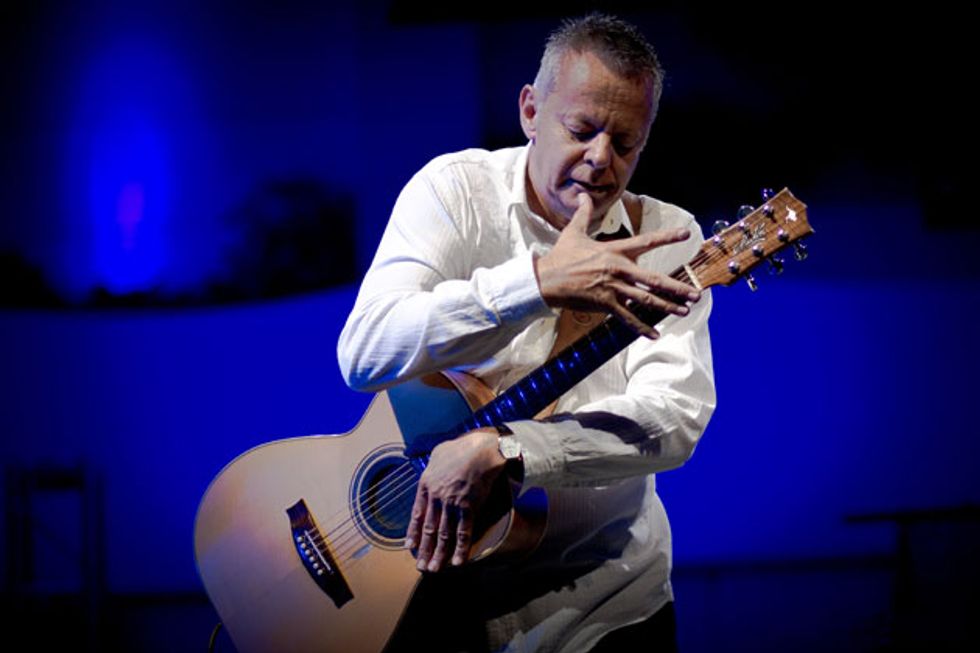
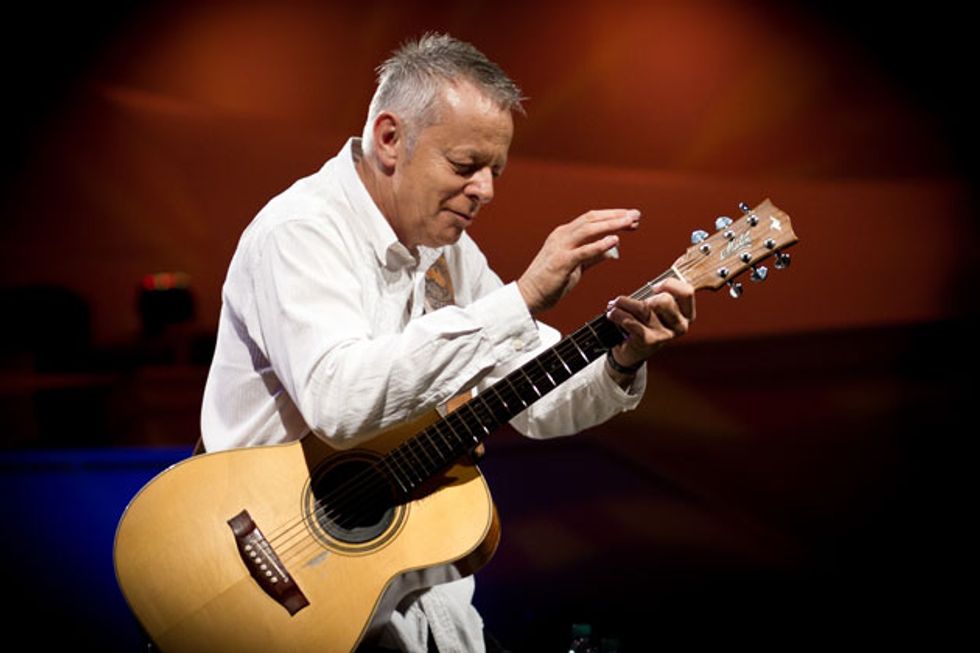
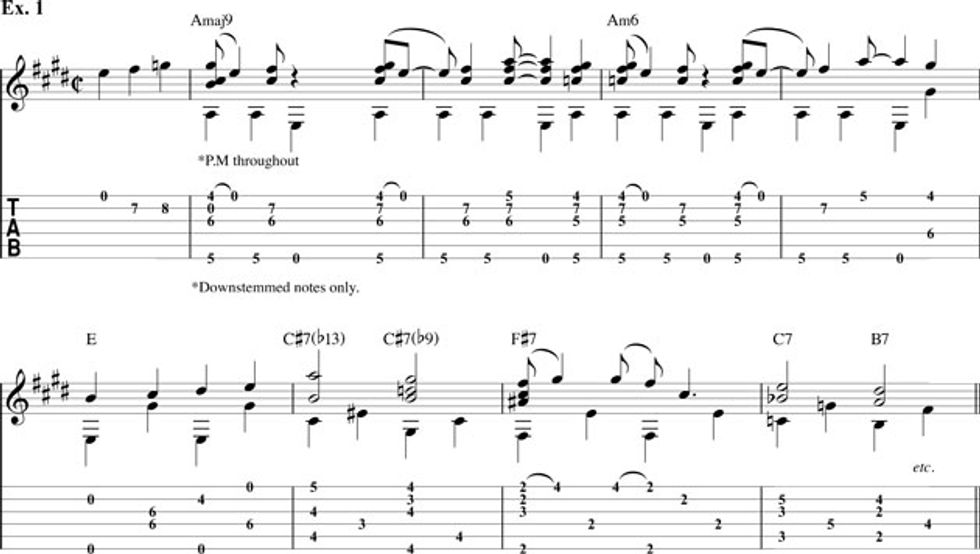
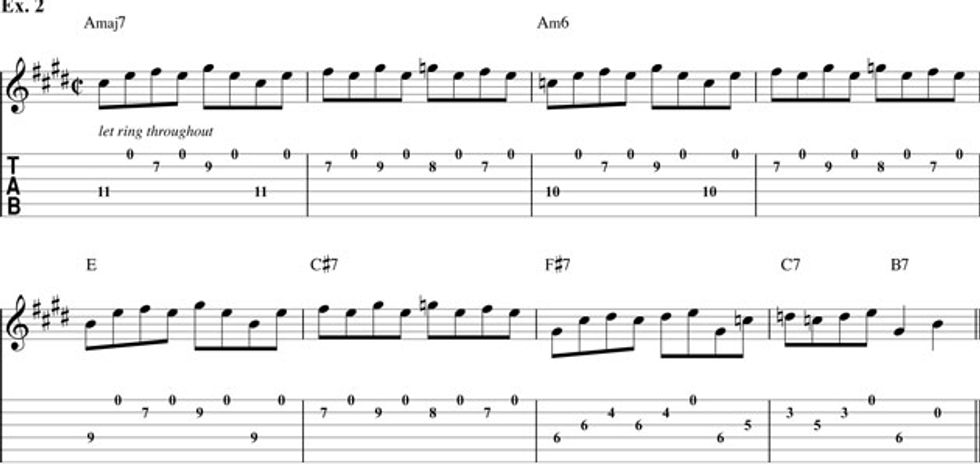
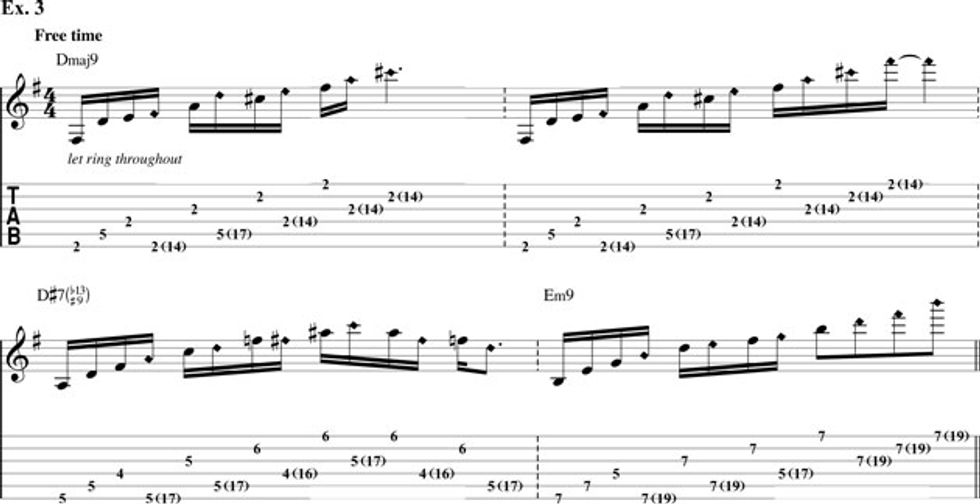
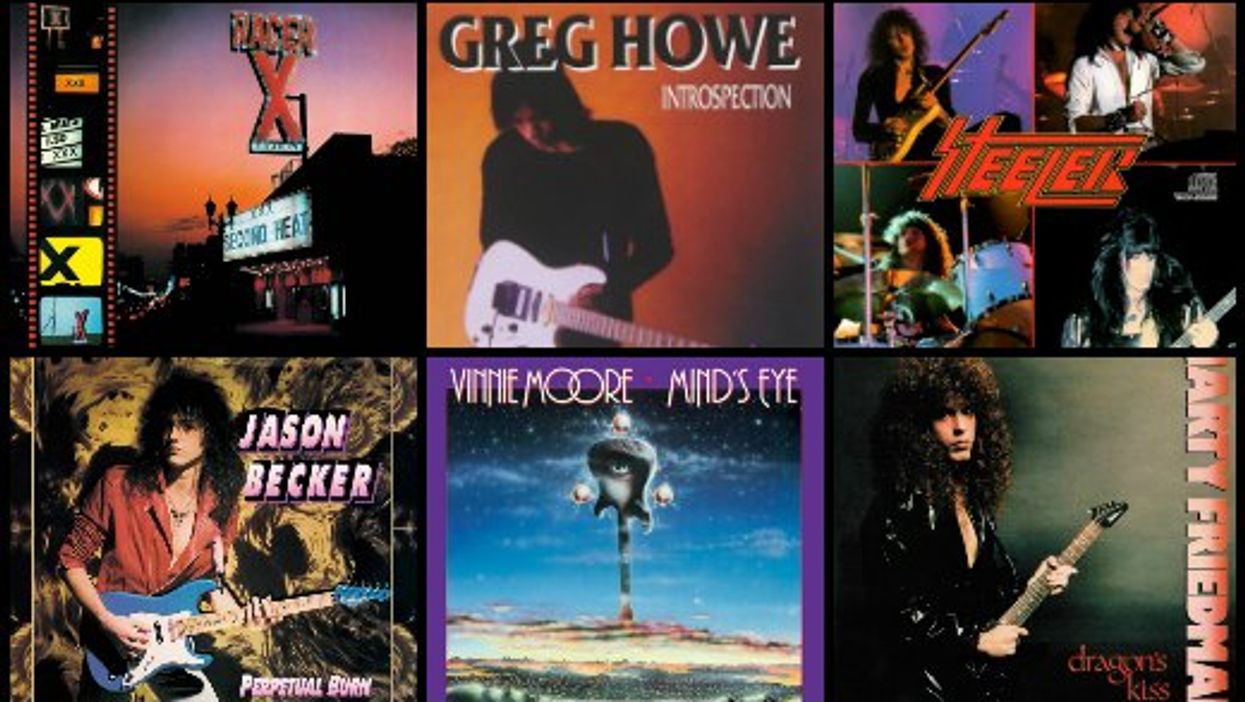
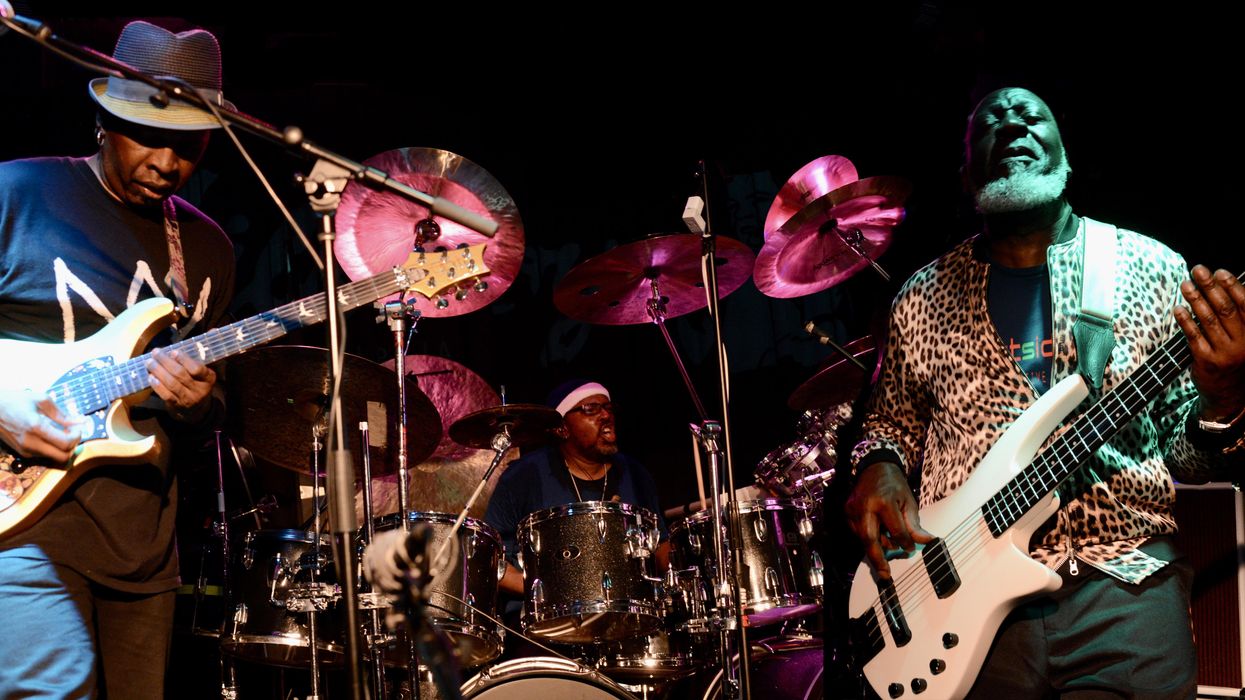
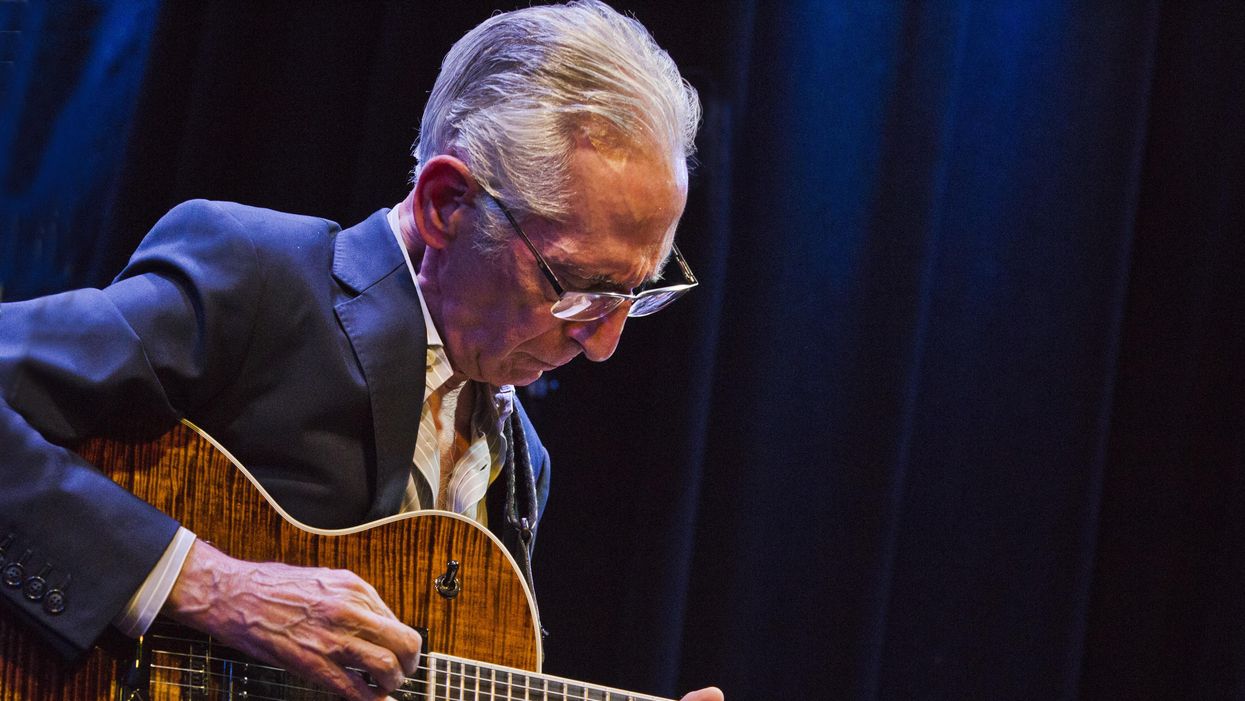



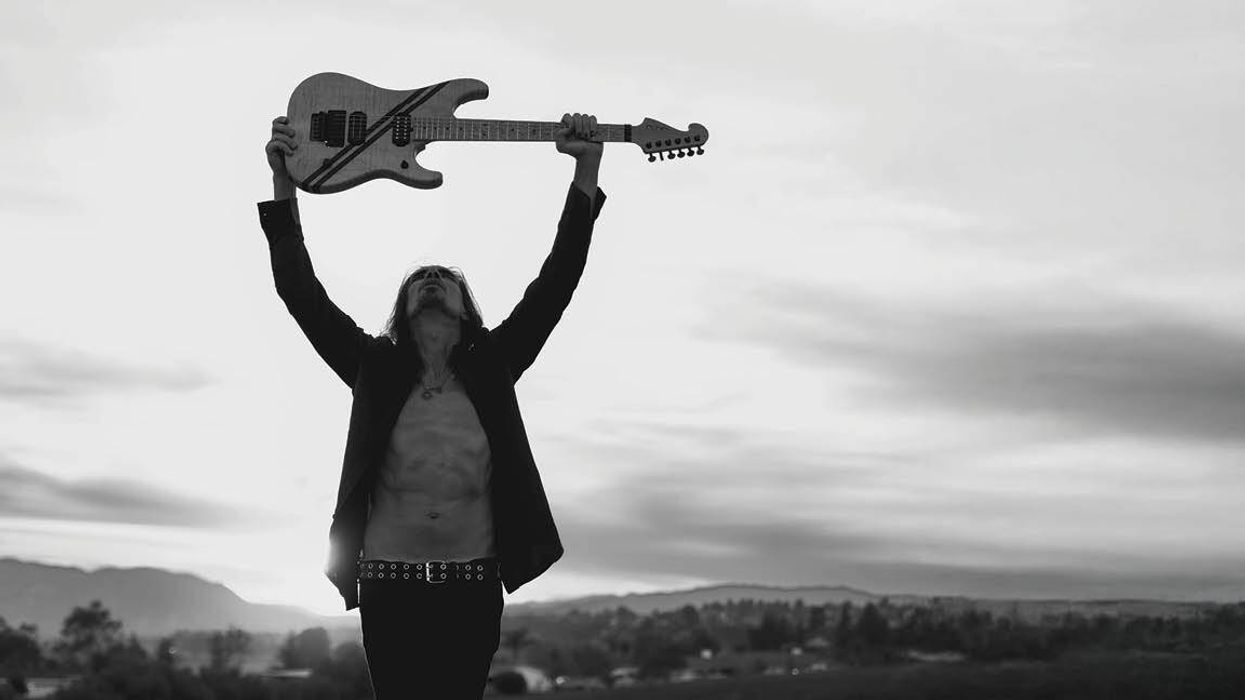
![Rig Rundown: Russian Circles’ Mike Sullivan [2025]](https://www.premierguitar.com/media-library/youtube.jpg?id=62303631&width=1245&height=700&quality=70&coordinates=0%2C0%2C0%2C0)













![Rig Rundown: AFI [2025]](https://www.premierguitar.com/media-library/youtube.jpg?id=62064741&width=1245&height=700&quality=70&coordinates=0%2C0%2C0%2C0)




















 Zach loves his Sovtek Mig 60 head, which he plays through a cab he built himself at a pipe-organ shop in Denver. Every glue joint is lined with thin leather for maximum air tightness, and it’s stocked with Celestion G12M Greenback speakers.
Zach loves his Sovtek Mig 60 head, which he plays through a cab he built himself at a pipe-organ shop in Denver. Every glue joint is lined with thin leather for maximum air tightness, and it’s stocked with Celestion G12M Greenback speakers.











